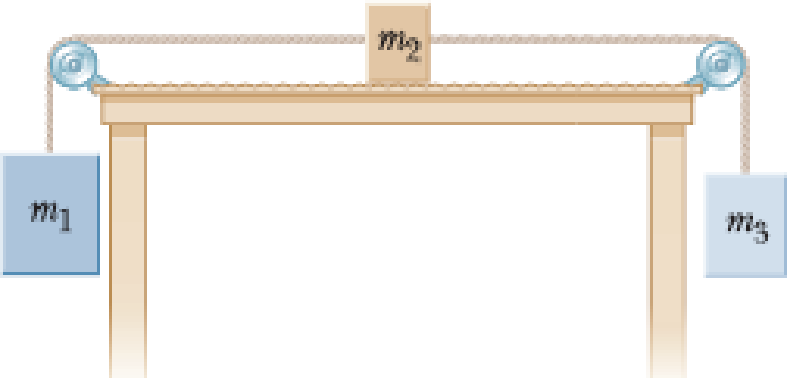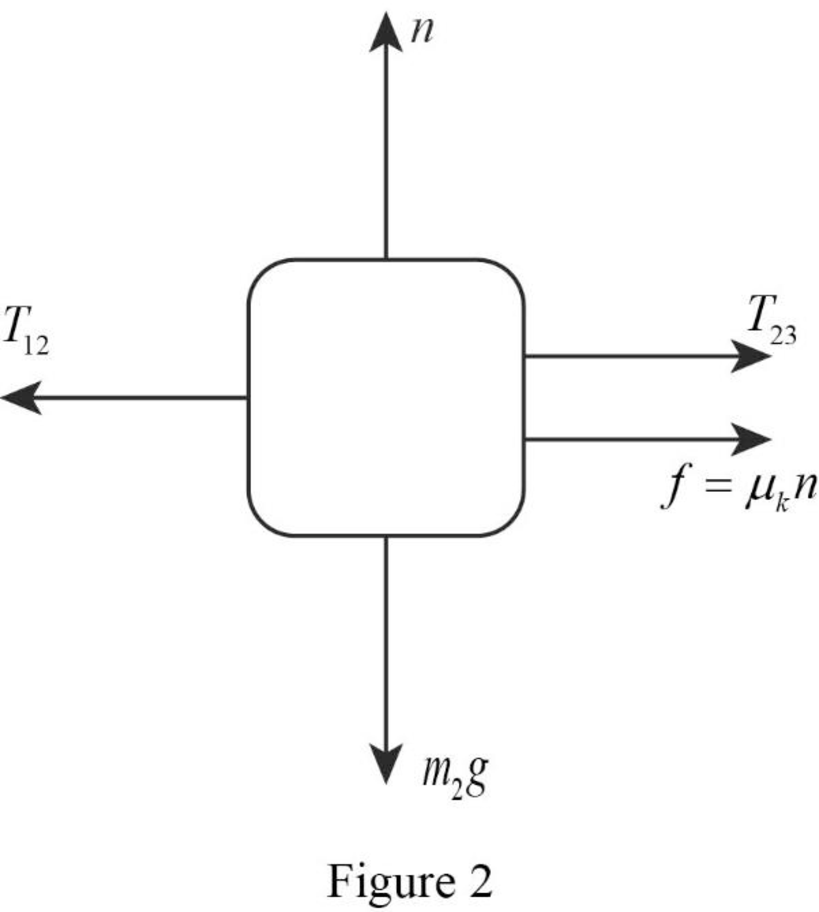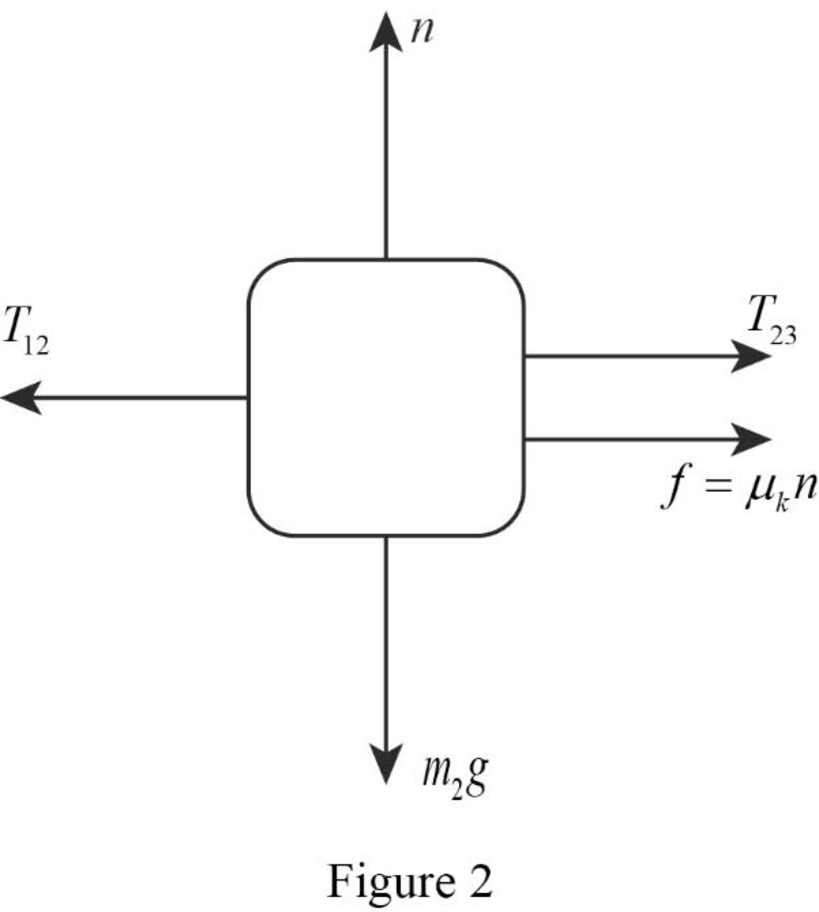
Concept explainers
Three objects are connected on a table as shown in Figure P5.14. The coefficient of kinetic friction between the block of mass m2 and the table is 0.350. The objects have masses of m1 = 4.00 kg, m2 = 1.00 kg, and m3 = 2.00 kg, and the pulleys are frictionless. (a) Draw a free-body diagram of each object. (b) Determine the acceleration of each object, including its direction. (c) Determine the tensions in the two cords. What If? (d) If the tabletop were smooth, would the tensions increase, decrease, or remain the same? Explain.

Figure P5.14
(a)
Draw free body diagram of the each object.
Answer to Problem 14P
The free body diagram of the mass of block

The free body diagram of the mass of block

The free body diagram of the mass of block

Explanation of Solution
The free body diagram is the graphical illustration used to visualize the movements and forces applied on a body.
Let
The free body diagram of the mass of block

The free body diagram of the mass of block

The free body diagram of the mass of block

Conclusion:
Therefore, the free body diagram of the mass of block
(b)
The magnitude and direction of acceleration of each object.
Answer to Problem 14P
The magnitude of acceleration of each object is
Explanation of Solution
Apply Newton’s second law for in the
Here,
From the Figure 1, write the expression for net force in the
Here,
Substitute,
From the Figure 2, write the expression for net force in the
Since,
Here,
From the Figure 2, write the expression for net force in the
From the Figure 3, write the expression for net force in the
Add equation (III), (IV), and (VI).
Write the expression for normal force for mass
Use,
Conclusion:
Substitute,
Therefore, the magnitude of acceleration of each object is
(c)
The tension in the two cords.
Answer to Problem 14P
Tension in the first code is
Explanation of Solution
Conclusion:
Substitute,
Substitute,
Therefore, tension in the first code is
(d)
Whether the tension increase, decrease, or remain the same if the tabletop were smooth.
Answer to Problem 14P
The tension in the left rope will decreases, and the tension in the right rope will increases.
Explanation of Solution
If the table top is smooth, the friction on the top will disappear. So the acceleration become larger.
From the equation (III),
Conclusion:
Therefore, the tension in the left rope will decreases, and the tension in the right rope will increases.
Want to see more full solutions like this?
Chapter 5 Solutions
Principles of Physics: A Calculus-Based Text
- Why is the following situation impossible? A 1.30-kg toaster is not plugged in. The coefficient of static friction between the toaster and a horizontal countertop is 0.350. To make the toaster start moving, you carelessly pull on its electric cord. Unfortunately, the cord has become frayed from your previous similar actions and will break if the tension in the cord exceeds 4.00 N. By pulling on the cord at a particular angle, you successfully start the toaster moving without breaking the cord.arrow_forwardA sleigh is being pulled horizontally by a train of horses at a constant speed of 8.05 m/s. The magnitude of the normal force exerted by the snow-covered ground on the sleigh is 6.37 103 N. a. If the coefficient of kinetic friction between the sleigh and the ground is 0.23, what is the magnitude of the kinetic friction force experienced by the sleigh? b. If the only other horizontal force exerted on the sleigh is due to the horses pulling the sleigh, what must be the magnitude of this force?arrow_forwardIf a single constant force acts on an object that moves on a straight line, the objects velocity is a linear function of time. The equation v = vi + at gives its velocity v as a function of time, where a is its constant acceleration. What if velocity is instead a linear function of position? Assume that as a particular object moves through a resistive medium, its speed decreases as described by the equation v = vi kx, where k is a constant coefficient and x is the position of the object. Find the law describing the total force acting on this object.arrow_forward
- An object of mass M is held in place by an applied force F and a pulley system as shown in Figure P4.43. The pulleys are massless and frictionless. (a) Draw diagrams showing the forces on each pulley. Find (b) the tension in each section of rope, T1, T2, T3, T4, and T5 and (c) the magnitude of F. Figure P4.43 44. Any device that allows you to increase the force you exert is a kind of machine. Some machines, such as the prybar or the inclined plane, are very simple. Some machines do not even look like machines. For example, your car is stuck in the mud and you cant pull hard enough to get it out. You do, however, have a long cable that you connect taut between your front bumper and the trunk of a stout tree. You now pull sideways on the cable at its midpoint, exerting a force f. Each half of the cable is displaced through a small angle from the straight line between the ends of the cable. (a) Deduce an expression for the force acting on the car. (b) Evaluate the cable tension for the case where = 7.00 and f = 100 N.arrow_forwardTwo objects, m1 = 3.00 kg and m2 = 8.50 kg, are attached by a massless cord passing over a frictionless pulley as shown in Figure P5.51. Assume the horizontal surface is frictionless. a. Draw a free-body diagram for each of the two objects. b. What is the tension in the cord? c. What is the magnitude of the acceleration of the two objects? FIGURE P5.51 Problems 51 and 65.arrow_forwardAn object of mass m = 1.00 kg is observed to have an acceleration a with a magnitude of 10.0 m/s2 in a direction 60.0 east of north. Figure P4.29 shows a view of the object from above. The force F2 acting on the object has a magnitude of 5.00 N and is directed north. Determine the magnitude and direction of the one other horizontal force F1 acting on the object. Figure P4.29arrow_forward
- A single-celled animal called a paramecium propels itself quite rapidly through water using its hair-like cilia. A certain paramecium experiences a drag force of Fdrag -bu? in water, where the drag coefficient b is approximately 0.330 kg/m. If the paramecium's speed v is 0.000157 m/s, what is the magnitude of the propulsion force that the creature must generate to move at this constant speed? -9 magnitude: 2.684 x10° Narrow_forwardTwo objects are connected by a light string that passes over a frictionless pulley as shown in Figure. Assume the incline is frictionless and take m1 = 2.00 kg, m2 = 6.00 kg, and θ = 55.0°. (a) Draw free-body diagrams of both objects. Find (b) the magnitude of the acceleration of the objects, (c) the tension in the string, and (d) the speed of each object 2.00 s after it is released from rest.arrow_forwardA stockroom worker pushes a box with mass 16.8 kg on a horizontal surface with a constant speed of 3.5 m/s. The coefficient of kinetic friction between the box and the surface is 0.2. What horizontal force must the worker apply to the box to maintain the constant velocity?arrow_forward
- A 1.9 kg otter starts from rest at the top of a muddy incline 84.1 cm long and slides down to the bottom in 0.60 s. What net external force acts on the otter along the incline? Answer in units of N.arrow_forwardTwo blocks of mass M and m are sitting on a horizontal floor. The blocks are touching. The coefficient of static friction between the smaller block and the floor is μs1, and the coefficient of static friction between the larger block and the floor is μs2. What is the minimum push force F so that the blocks begin to move?arrow_forwardConsider the figure shown in the following figure. You are lowering two boxes, one on top of the other, down a ramp by pulling on a rope parallel to the surface of the ramp. Both blocks move with constant velocity of 10.0 [m/s]. The coefficient of kinetic friction between the ramp and the lower box is 0.555 and the coefficient of static friction between the two boxes is 0.750.4. What is the magnitude of the applied force?5. Determine the angle at which the top block will start to slide down the bottomarrow_forward
 Principles of Physics: A Calculus-Based TextPhysicsISBN:9781133104261Author:Raymond A. Serway, John W. JewettPublisher:Cengage Learning
Principles of Physics: A Calculus-Based TextPhysicsISBN:9781133104261Author:Raymond A. Serway, John W. JewettPublisher:Cengage Learning Physics for Scientists and Engineers: Foundations...PhysicsISBN:9781133939146Author:Katz, Debora M.Publisher:Cengage Learning
Physics for Scientists and Engineers: Foundations...PhysicsISBN:9781133939146Author:Katz, Debora M.Publisher:Cengage Learning Glencoe Physics: Principles and Problems, Student...PhysicsISBN:9780078807213Author:Paul W. ZitzewitzPublisher:Glencoe/McGraw-Hill
Glencoe Physics: Principles and Problems, Student...PhysicsISBN:9780078807213Author:Paul W. ZitzewitzPublisher:Glencoe/McGraw-Hill


